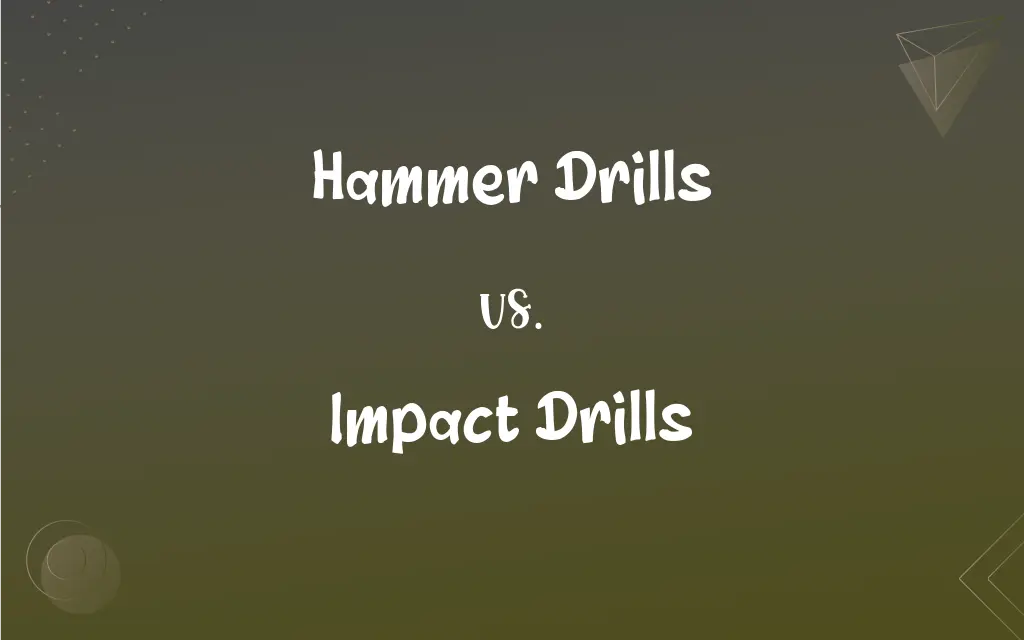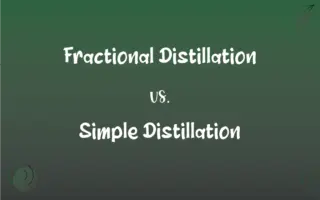Hammer Drills vs. Impact Drills: What's the Difference?
Edited by Aimie Carlson || By Harlon Moss || Updated on October 25, 2023
Hammer drills provide rapid hammering action for drilling in masonry; impact drills exert rotational force for driving screws.

Key Differences
Hammer drills are designed to combine rotational drilling with a rapid back-and-forth hammering motion. This hammering action helps break up masonry materials like brick or concrete, making it easier for the drill bit to bore through. Impact drills, on the other hand, focus on delivering high torque in rotational bursts, making them ideal for tasks like driving screws or fastening bolts.
Hammer drills excel when drilling into hard, brittle materials where the hammering function can assist the drill bit's progression. This tool is particularly valuable for construction professionals and DIY enthusiasts working on masonry projects. Conversely, impact drills offer sudden rotational impacts, ensuring screws are driven deep without stripping their heads or causing user fatigue.
When choosing between hammer drills and impact drills, the nature of the job is crucial. If the task involves drilling holes into concrete, brick, or stone, a hammer drill is the go-to choice. For projects centered around fastening or requiring high torque, an impact drill becomes indispensable.
Both hammer drills and impact drills are valuable tools in a craftsman's arsenal. While there's some overlap in their capabilities, each serves specific roles. Hammer drills target masonry drilling, while impact drills focus on fastening tasks with rotational force.
The difference in design between hammer drills and impact drills reflects their distinct applications. While both can handle general drilling, the hammering function of hammer drills makes them superior for masonry, whereas the torque bursts from impact drills optimize them for tasks like driving screws.
ADVERTISEMENT
Comparison Chart
Primary Function
Drilling through masonry with hammering action.
Driving screws with high rotational torque.
Mechanism
Combines rotation with rapid back-and-forth hammering.
Delivers rotational impacts for increased torque.
Best Used For
Concrete, brick, and stone drilling.
Fastening tasks, like screw driving or bolt tightening.
Torque
Consistent but may be lower than impact drills.
Intermittent high torque in short bursts.
Physical Reaction
Can feel like a constant push in line with the drill bit.
Feels like a pulsating rotational force perpendicular to the screw.
ADVERTISEMENT
Hammer Drills and Impact Drills Definitions
Hammer Drills
Hammer drills provide rapid hammering actions to aid in drilling hard materials.
Hammer drills are essential when working with brick and stone.
Impact Drills
Impact drills use rotational impacts to deliver high torque.
The impact drills made driving long screws into the wood effortless.
Hammer Drills
Hammer drills combine rotational and hammering motions for effective masonry drilling.
He used the hammer drills to make holes in the concrete wall.
Impact Drills
Impact drills are known for their efficiency in driving screws deep without causing fatigue.
With impact drills, she finished her decking project quickly.
Hammer Drills
Hammer drills are equipped with a mechanism that creates a pounding motion to complement spinning.
For his brick project, he knew only hammer drills would suffice.
Impact Drills
Impact drills prevent screw stripping with their pulsating torque mechanism.
Impact drills are ideal for projects that involve lots of screw driving.
Hammer Drills
Hammer drills often feature a switch to toggle between regular and hammering modes.
She turned off the hammering function on her hammer drills when drilling wood.
Impact Drills
Impact drills are optimized for fastening tasks rather than drilling.
He grabbed his impact drills when he needed to tighten several bolts.
Hammer Drills
Hammer drills are specifically designed to tackle hard, brittle materials.
Masonry tasks become more manageable with the right hammer drills.
Impact Drills
Impact drills produce bursts of high torque, ideal for tough fastening tasks.
When faced with rusted screws, only his impact drills could get the job done.
FAQs
Can I drill wood using hammer drills?
Yes, many hammer drills have a switch to toggle off the hammering function for regular drilling.
When should I use impact drills?
Impact drills are best for driving screws and tasks requiring high rotational torque.
What's the primary purpose of hammer drills?
Hammer drills are designed for drilling into masonry materials using a hammering action.
How do impact drills handle torque differently than regular drills?
Impact drills deliver torque in sudden bursts, allowing more power without continuous strain.
Can I use regular drill bits with hammer drills?
While possible, it's recommended to use bits designed for masonry when using the hammering function.
Can impact drills be used for drilling holes?
Yes, but they're optimized for fastening. For regular drilling, a standard drill or hammer drill might be more effective.
Can I control the torque on impact drills?
Many models allow for torque adjustments to suit different tasks.
Which is generally more expensive: hammer drills or impact drills?
Prices vary based on features and brands, but specialized hammer drills can sometimes be pricier due to their dual functionality.
Can I use hammer drills for tasks suited for impact drills, and vice versa?
While there's some overlap, each tool is optimized for specific tasks; using them interchangeably might not yield the best results.
Is the noise level different between hammer drills and impact drills?
Hammer drills tend to produce a consistent drilling noise, while impact drills have a distinct pulsating sound.
Do I need both hammer drills and impact drills in my toolkit?
Depending on the variety of tasks you undertake, having both can provide versatility.
What kind of tasks is an impact drill not suitable for?
Impact drills aren't ideal for precision drilling or masonry drilling without the proper bits.
Do impact drills strip screw heads?
Impact drills are designed to prevent stripping by delivering high torque in rotational bursts.
Are hammer drills heavier than impact drills?
Generally, hammer drills might be bulkier due to their added hammering mechanism.
Which drill type causes more fatigue to the user?
Hammer drills can be more tiring in prolonged use, especially without anti-vibration features.
How does the hammering function in hammer drills work?
It combines rotation with a rapid back-and-forth hammering motion to aid in drilling hard materials.
How do I know when to use the hammering function on hammer drills?
Use it when drilling into hard, brittle materials like concrete, brick, or stone.
Can hammer drills damage delicate materials?
Yes, the hammering action can be too aggressive for soft or delicate materials.
Do all impact drills operate at the same torque?
No, different models offer varying torque levels, depending on their design and purpose.
Which is faster at driving screws: hammer drills or impact drills?
Impact drills are typically faster and more efficient at driving screws.
About Author
Written by
Harlon MossHarlon is a seasoned quality moderator and accomplished content writer for Difference Wiki. An alumnus of the prestigious University of California, he earned his degree in Computer Science. Leveraging his academic background, Harlon brings a meticulous and informed perspective to his work, ensuring content accuracy and excellence.
Edited by
Aimie CarlsonAimie Carlson, holding a master's degree in English literature, is a fervent English language enthusiast. She lends her writing talents to Difference Wiki, a prominent website that specializes in comparisons, offering readers insightful analyses that both captivate and inform.






























































